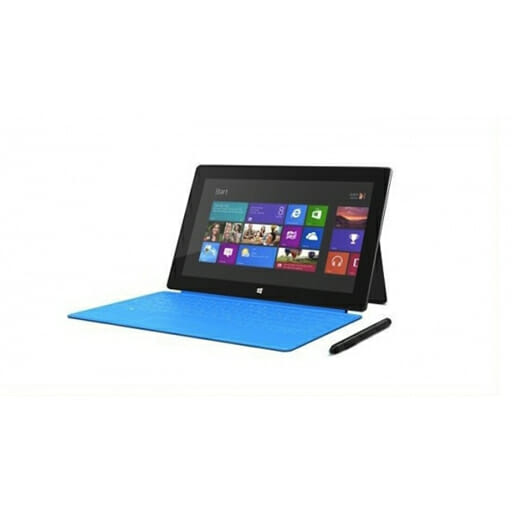
Ever since its announcement back in April of 2012, the idea behind the Microsoft Surface has been attractive and original. The thinking behind this laptop/tablet hybrid recognizes a couple of important things about the way people use computers and tablets that many other devices ignore altogether. Most importantly, the Surface products understand that people really love to use their tablets, but they often wished they didn’t have to lug around a laptop with them for when they actually need to get some work done.
But are the strange ergonomics of the Surface Pro really the best solution for the tablet-laptop dichotomy? Does the split OS of Windows 8 really bridge the gap in the most efficient way?
The Surface Pro is the second installment in Microsoft’s new line of Windows 8 tablet/laptop mashups—the first being the lighter, more underpowered Surface RT. Both devices are not only the first of their kind in terms of wonky hybrid design, but are also a big first step for Microsoft as computer hardware designers. Outside of the Xbox, Microsoft has left hardware manufacturing to their partners such as Asus, Samsung, Dell or Lenovo, so it’s clear now that the Surface products are not just demos or inspirational examples to push OEMs. The Surface represents Microsoft’s future as a tech company.
When the first version of the Surface was released back in October last year, those looking for a way to ditch their laptops didn’t find a lot they could hold on to. It felt like just another Windows 8 tablet. Consequently, people who were dissatisfied by the underpowered processing in the Surface RT should find a lot to like in the Surface Pro. The device has an actual Intel i5 processor that runs the Windows 8 operating system flawlessly. Apps open quickly, gestures register fluidly, and the device can handle important pieces of software like Photoshop and Steam.
The Surface Pro boasts a beautiful 1080p 10.6” screen that does look great. Significantly bumping up the stats here from the Surface RT, Microsoft has really done some fantastic things with the display here that put it at the same level as the fourth generation iPad. In terms of the aesthetics of the hardware design in general, the Surface’s sleek professional feel is impressive and robust—a sturdy piece of professional hardware. But the aesthetics are pretty much where the compliments about the Surface’s exterior design ends.
For starters, the 16:9 screen ratio is really awkward to hold as a tablet, especially in portrait mode. That’s no surprise, but it certainly reinforces the idea that the Surface Pro was made to be used with its detachable keyboard hooked in. Secondly, you won’t find yourself wanting to use the Surface Pro much as a tablet anyways, considering its battery life is no more than 4 hours and it weighs upwards of 2 lbs. If you consider the pack that the device’s dual-core Intel i5 processor and 4GB of ram punches, that’s not as bad as it seems. But the second you start picking this thing up and using it like a tablet, those 4 hours will go by really quickly.
All that would be good and well if the Surface Pro could easily replace your standard ultrabook and the tablet mode was just an additional feature. Unfortunately, you’ll find that you’ll end up sacrificing lot of the functionality of a normal laptop when you use the Surface Pro. Not only does Windows 8 itself not let you work in its classic Windows mode without having to go into the new Windows mode, you’ll also even have to compromise a lot of the sitting positions that you’ve grown accustomed to. Say goodbye to using your computer on your lap on a park bench or on your couch. The built-in kick stand’s single unfortunate viewing angle doesn’t help any either, making even using the device at a desk an uncomfortable experience.
The line of Microsoft Surface products combined with Windows 8 is the solution to a very specific problem in consumer electronics. Every year, as tablets take more and more market share from netbooks, ultrabooks, and laptops as a whole, the problem becomes more and more apparent. People love the lightweight, mobile, consumption-driven feel of tablets. So what’s the problem? They are also finding that they are needing to lug around a laptop as well if they want to get any serious work done. It’s the problem of needing two different mobile devices with you all the time: one for consumption and one for creation. Nailing this balance between work and play is what made form factors like the touchscreen smartphone or the laptop such a natural success. The Surface Pro’s honorable attempts to do this same balancing act for tablets feel forced, as is the nature of Windows 8.
The Surface products are the beginning of an answer to that problem. They are the start of a conversation—not quite the correct solution, but certainly an interesting icebreaker.